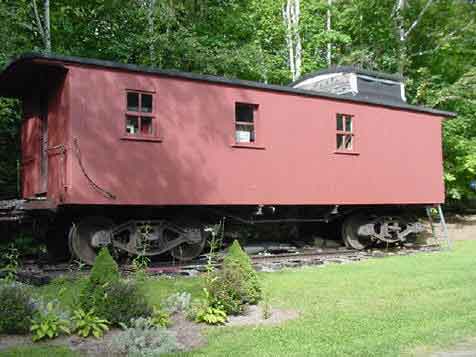Moving & Restoring

 This is the cupola prior to trucking the caboose to Bolton. Daylight was clearly visible through the roof boards before removal. We had to disassemble the cupola to reduce the height of the caboose so that it would not be too tall when loaded on the flatbed. Most pieces were saved to serve as patterns for later restoration.
This is the cupola prior to trucking the caboose to Bolton. Daylight was clearly visible through the roof boards before removal. We had to disassemble the cupola to reduce the height of the caboose so that it would not be too tall when loaded on the flatbed. Most pieces were saved to serve as patterns for later restoration.
Spreaders should really be used to keep the cables from chewing up the roof edge, but we had switched crane operators at the last minute, and the folks at Cote Riggers did not have any spreaders available. They gave us a really great deal, and the entire roof needed to be replaced anyway, so it was no big deal.
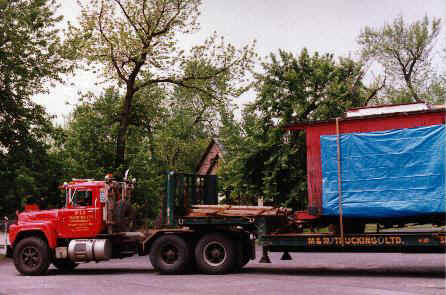
Trucking expenses can be extremely high when moving railroad cars. We needed two low-boy trailers, one for the "doghouse" and the other for the trucks. Luckily, we connected with M&R Trucking, in Richmond, VT. These guys are pros who love a challenge. If they charged us any less to move the caboose, they would have done it for free. The blue tarp was to keep rotten car siding from blowing off and creating a road hazard in transit. You cannot see it in the photo, but the tarp is covered with chicken wire to keep it from flapping off.
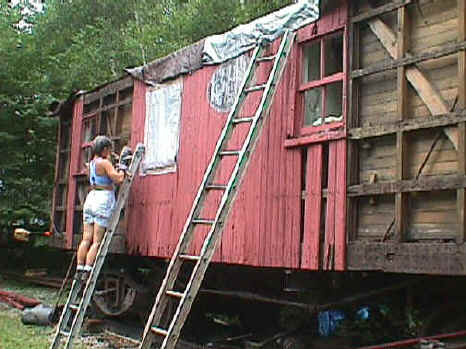
Jeanne is stripping the rotten car siding from NYC 19520, built approx. 1917. Judging from the wood behind the siding, it has been replaced at least twice in the past.
The siding is removed, showing the bracing. The wooden braces are opposed by diagonal 5/8" steel rods that run through the top and bottom sills. Everything except the car siding appears to be original, showing numerous repairs that took place over the years.
Even though 19520 will never ride the rails again, restoration is being done to return this piece of history to as close to original condition as is practical on our meager budget. This meant patching braces and even remaking some of the threaded rods. Most of the original wooden components were made from heartwood southern yellow pine. It appears that this heavily resinous wood was used for its exceptional water resistance. Still, many pieces were heavily split, due to excessive nailing and years of damp and dry cycles. Much effort was expended custom making pieces that closely followed the originals, and patching salvageable pieces.
The old wooden cabin was twisted in all three dimensions, due to 50 years of "slack action" impact and general tough use. It appears that this war bird may have been in a pretty serious accident, as half of the top sill on the other side was replaced some time while the car was in service. There is other evidence as well of some extreme impact. The car was not as well braced sideways as it was end to end, causing quite a bit of lean on one end. The car was straightened as much as possible as siding and roofing were replaced.

Here is detail of the edge of the roof, after the 1" tongue and groove boards had been replaced.
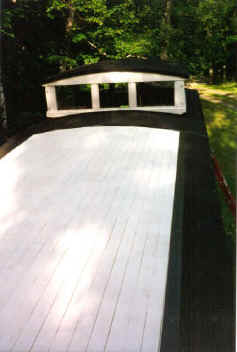 Though far from original, roof and eaves membrane was installed to protect roof edges and siding. The original roof was covered with tar impregnated canvas, which had been replaced several times. It was evident that the roof boards had been replaced at least once as well. The special canvas may be available, as it was also used for automobile tops up until the 1930's, but it was beyond our budget, so humble black roll roofing was applied over tar paper, instead.
Though far from original, roof and eaves membrane was installed to protect roof edges and siding. The original roof was covered with tar impregnated canvas, which had been replaced several times. It was evident that the roof boards had been replaced at least once as well. The special canvas may be available, as it was also used for automobile tops up until the 1930's, but it was beyond our budget, so humble black roll roofing was applied over tar paper, instead.
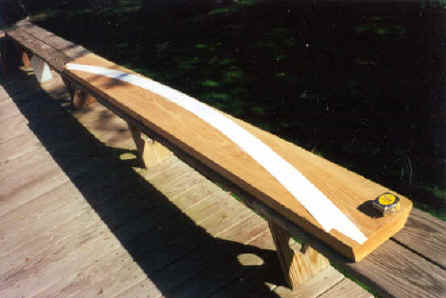
One roof bow needed to be replaced (others were repaired with epoxy). White oak was used to match the original. It is hard for a woodworker to use such a magnificent piece of wood to cut one piece (that's a $75 board there), but that's the way the originals were made. The pattern was created by carefully measuring the original, averaging the measurements with those of similar pieces still on the car, and recreating it with computer-aided drafting (CAD) software.
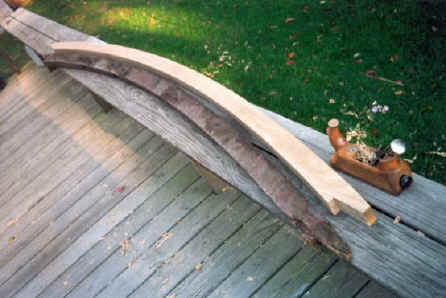
The completed brace compared with the original. NYC used white oak to provide needed strength and water resistance. I confess to being a lot more careful about craftsmanship than the shop men who created the original. Cabooses were industrial utility cars, and were built to a much lower standard of finish than passenger coaches. I suspect that caboose building was used as a way to break in inexperienced workers. The original braces were bandsawn to shape, with no additional shaping or smoothing.
The NYC built 19520 in its own shops in Rochester. NY. I believe they built all of the 19000 series of cabooses.
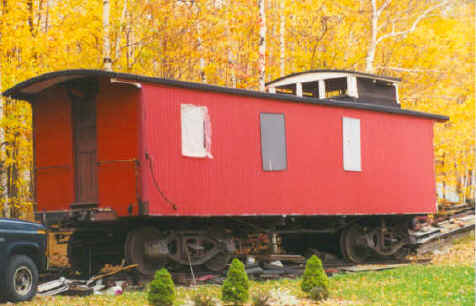
The siding and roofing installed, 19520 awaits its windows. We custom-milled the siding to match the V-groove style we think was most similar to the original. Although no original siding remained on the outside, and the inside had been patched and rebuilt several times as well, there are areas inside that we are fairly sure are original, and it was from these areas that we established the groove profile.
One of the things we really like about 19520 is that, although it has suffered from years of neglect, it is substantially complete. It was never gutted for use as a camp or hotdog stand, as happens with many old cabooses. It had been fairly heavily vandalized by underage partiers while being used as a display outside a restaurant, yet the original benches, wooden lockers, sink and even the icebox are still intact. We also have most of the metalwork, including grab-rails, steps, brake-wheels, ladders, etc. Eventually we hope to restore all of these pieces as a way of helping people understand the environment in which 20th century railmen worked. My grandfather was a lifelong NYC railman, as were several other men on that side of my family. My father's first job was as a railroad messenger in Corning New York in the 40's. They must have seen cabooses just like 19520 many times in their daily work.
The NYC once had hundreds of 19000 series cabooses in service. Today, only a few remain. I have seen a later steel NYC caboose made in the same pattern as the 19000 series wooden cabooses, so the design was a durable one. The Rochester & Genesee Valley Railroad Museum has done a wonderful job restoring NYC 19877.
Last edited 12/31/2019
By Steve Barner,
